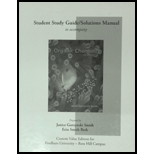
Concept explainers
(a)
Interpretation: The product formed by the ring-opening metathesis
Concept introduction: The ring-opening metathesis polymerization takes place, when cycloalkenes (starting material) are allowed to react with Grubbs catalyst. The reaction yields high molecular weight
(b)
Interpretation: The product formed by the ring-opening metathesis polymerization of given alkene is to be stated.
Concept introduction: The ring-opening metathesis polymerization takes place, when cycloalkenes (starting material) are allowed to react with Grubbs catalyst. The reaction yields high molecular weight polymer. In this reaction one
(c)
Interpretation: The product formed by the ring-opening metathesis polymerization of given alkene is to be stated.
Concept introduction: The ring-opening metathesis polymerization takes place, when cycloalkenes (starting material) are allowed to react with Grubbs catalyst. The reaction yields high molecular weight polymer. In this reaction one
Want to see the full answer?
Check out a sample textbook solution
Chapter 26 Solutions
Organic Chemistry -Study Guide / Solution Manual (Custom)
- What is the first step in the cationic polymerization of alkenes?arrow_forwardRank the following groups of monomers from most able to least able to undergo cationic polymerization:arrow_forwardExplain why a random copolymer is obtained when 3,3-dimethyl-1-butene undergoes cationic polymerization.arrow_forward
- Explain why acrylonitrile (CH2 = CHCN) undergoes cationic polymerization more slowly than but-3-enenitrile (CH2 = CHCH2CN).arrow_forwardComplete the following condensation polymerization reactions by drawing the structural formula of the repeating unitof each polymer, as well as any other products.arrow_forwardCompound A is a novel poly(ester amide) copolymer that can be used as a bioabsorbable coating for the controlled release of drugs. A is a copolymer of four monomers, two of which are amino acids or amino acid derivatives. The body’s enzymes recognize the naturally occurring amino acids in the polymer backbone, allowing for controlled enzymatic breakdown of the polymer and steady release of an encapsulated drug. Identify the four monomers used to synthesize A; then use Figure 29.2 to name the two amino acids.Figure 29.2: The 20 naturally occurring amino acidsarrow_forward

 Organic ChemistryChemistryISBN:9781305580350Author:William H. Brown, Brent L. Iverson, Eric Anslyn, Christopher S. FootePublisher:Cengage Learning
Organic ChemistryChemistryISBN:9781305580350Author:William H. Brown, Brent L. Iverson, Eric Anslyn, Christopher S. FootePublisher:Cengage Learning Chemistry: Principles and PracticeChemistryISBN:9780534420123Author:Daniel L. Reger, Scott R. Goode, David W. Ball, Edward MercerPublisher:Cengage Learning
Chemistry: Principles and PracticeChemistryISBN:9780534420123Author:Daniel L. Reger, Scott R. Goode, David W. Ball, Edward MercerPublisher:Cengage Learning


